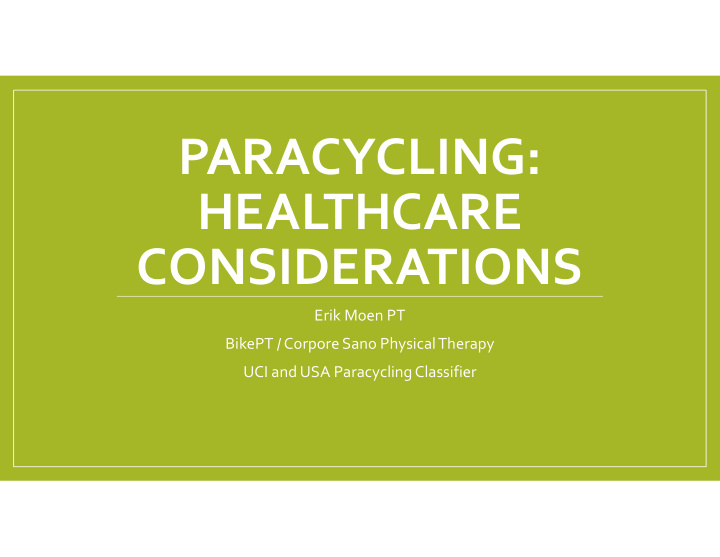



PARACYCLING: HEALTHCARE CONSIDERATIONS Erik Moen PT BikePT / Corpore Sano Physical Therapy UCI and USA Paracycling Classifier
What is Parasport? • International Paralympic Committee (IPC) • www.Paralympic.org • Vision: Make for an inclusive world through Para sport. • Mission: To lead the Paralympic Movement, oversee the delivery of the Paralympic Games and support members to enable Para athletes to achieve sporting excellence. • International rules and standards for parasport participation and competition. • Athlete CLASSIFICATION standards
International Cycling Union (UCI) • International Governing Body for Competitive Cycling • https://www.uci.org/para ‐ cycling • Racing: Road and Track • Events: World Cups and World Championships • Officiating • Classification • https://www.uci.org/para ‐ cycling/classification • Amends rules on the paralympic quadrennial
US Paracycling • United States Olympic and Paralympic Committee (USOPC) • www.TeamUSA.org • www.teamusa.org/usparacycling • Participation/competition rules mirror UCI • Not currently directly affiliated with USA Cycling
The UCI has set Minimum Impairment Minimum Criteria (MIC) to ensure that an Athlete’s Eligible Impairment affects the extent to Inclusion which an Athlete is able to execute the Criteria (MIC) specific tasks and activities fundamental to Para ‐ cycling.
• Impaired power • Impaired passive range of motion • Limb deficiency • Leg length difference ELIGIBLE • Hypertonia IMPAIRMENTS • Ataxia • Athetosis • Vision impairment
INELIGIBLE IMPAIRMENTS • Pain • Impaired motor reflex functions • Hearing impairment • Impaired cardiovascular functions • Low muscle tone • Impaired respiratory functions • Hypermobility of joints • Impaired metabolic functions • Joint instability • Tics and mannerisms, stereotypes and motor perseverations • Impaired muscle endurance • Short stature
SPORT CLASS PROFILES “The UCI defines a Sport Class in which athletes are grouped based on the impact of their Eligible Impairment on their ability to execute the specific tasks and activities fundamental to Para ‐ cycling.”
“VI” is for Vision Impairment • Impairment is evaluated by Ophthalmic Doctor • Does not go through other classification • Uses tandem bicycle • VI athlete is stoker • Pilot elite amateur
“C” IS FOR CYCLE C1 – C5
C1 • Limb Deficiencies • Athetoid • Impaired power • Hypertonia
C2 • Most typical is above the knee amputation without use of prosthesis • Impaired power: CMT (progressive)
C3 Bilateral below the knee amputation Hyper/hypotonia; loss of use of lower extremity. Combination of power impairment and limb deficiency
C4 Typical and most competitive is the below the knee amputation Grade 1 hypertonia in bilateral limbs
C5 • Nonfunctional foot or hand • Above elbow amputee • Hypertonia grade 1 in extremity with clear neurological signs
“H” IS FOR HANDCYCLE H1 – H5
H1 Tetraplegic with impairments corresponding to a motor complete cervical lesion at C6 or above Complete loss of trunk stability and lower limb function Limited triceps Bilateral loss of handgrip
H2 Tetraplegic with impairments corresponding to a motor complete cervical lesion at C7/C8 or above Complete loss of trunk stability and lower limb function Triceps and biceps strength at least muscle grade 3 Bilateral impaired handgrip
H3 • Paraplegic with impairments corresponding to a motor complete lesion from Th1 to Th10 • Trunk stability varies from very limited to limited trunk stability with a muscle grade of 0 ‐ 4
H4 • Eligible impairment(s) which prevent an athlete from using a bicycle, tricycle or kneeling/sitting position on a hand ‐ cycle due to underlying health conditions • Paraplegic with impairments corresponding to a complete lesion from Th11 or below • Normal or almost normal trunk stability
H5 Eligible impairment(s) which prevent an athlete from using a bicycle or tricycle and who can use the kneeling/sitting position must use this position Typical is complete spinal cord lesion Th11 or below Normal abdominal strength, and normal trunk extension strength
“T” IS FOR TRIKE Unable to ride a bicycle due to lack of balance and/or severe restriction in pedaling due to spasticity/ataxia/athetosis/dystonia T1 –T2
T1 Hypertonia − Spasticity grade 3 in a ff ected lower and upper limb(s) Bilateral or unilateral involvement, symmetrical and asymmetrical (2, 3 or 4 limbs strongly affected) Poor functional strength in trunk Hypertonia on activity in the lower and upper limbs as well as trunk affects posture and balance on tricycle Ataxia − Shows constant clear severe signs Athetosis/Dystonia − Severe: Constant signs with large amplitude of movement or extreme intensity of posturing
T2 More fluent movement pattern and better control of tricycle Hypertonia − Spasticity grade 2 in affected lower and upper limb(s) Hypertonia on activity can be seen Ataxia − frequent and moderate Athetosis/Dystonia − Frequent to intermittent signs with maximum to moderate intensity of posturing or amplitude of movement
• Recruitment of athletes The Role of the • Completion of Medical Healthcare Diagnosis Form (MDF) Provider • Become a classifier
Paracycling Classification: Your Role • www.teamusa.org/usparacycling/classification • Completion of MDF • National and International • Chose an impairment that best describes athlete • Refer to UCI Rule 16.5.002 • Evaluations and tests to verify the selected impairment
Thank You! • Erik Moen PT • USAParacycling and UCI Classifier • Erik@BikePT.com • www.BikePT.com • www.CorporeSanoPT.com • Kenmore, WA USA
Recommend
More recommend